Equipment and Furniture
Much of the equipment in stiffening, book repair, and conservation is very similar and often interchangeable. For this reason, some standardization is useful, especially of furniture type and design. The following specifications are based on substantial experience working with a variety of operations in different institutions, and it is understood that there may need to be some variation based on the particular configuration and amount of space available.
Please click on the links below to learn more about the equipment and furniture needed to maintain your facilities.
Stiffening
The two pieces of equipment crucial to a productive stiffening operation are a gluing machine and a power paper cutter.
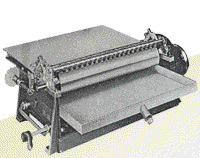
The gluing machine should be a minimum of 40 centimeters in width and be capable of gluing both boards and flexible materials without requiring resetting. The glue for the machine should be cold and preferably a polyvinyl acetateadhesive. The machine should be mounted on a stand with wheels so that it can be rolled to the sink for ease of cleaning.
The power paper cutter should be capable of cutting up to 10 centimeters in thickness and have a cutting width of at least 80 centimeters. The cutter should be equipped with required safety devices to prevent injury.
The main processing or standard bench is of the same design as that used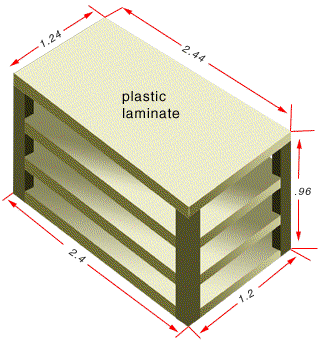 for all conservation work, with a standard height of 96 centimeters, a width of 1.24 meters, and a length of 2.44 meters (38 inches x 4 feet x 8 feet). A counter of the same height and length with a width of 60 centimeters (38 inches x 8 feet x 3 feet), plus at least two other similar counters designed to fit the space, is useful.
for all conservation work, with a standard height of 96 centimeters, a width of 1.24 meters, and a length of 2.44 meters (38 inches x 4 feet x 8 feet). A counter of the same height and length with a width of 60 centimeters (38 inches x 8 feet x 3 feet), plus at least two other similar counters designed to fit the space, is useful.
The bench and the counter 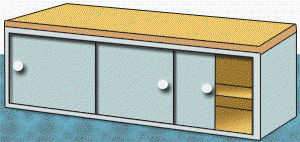 have storage space under them for supplies cut to standard sizes. All benches should be sturdy and have a washable plastic laminate top.
have storage space under them for supplies cut to standard sizes. All benches should be sturdy and have a washable plastic laminate top.
Book repair
The book repair operation is not dependent on heavy equipment or complex space configurations. The standard bench can be used by at least three technicians if need be. The bench is used for all repair work, but the work flows better if there is also a counter adjacent to the group to accommodate some tasks. This saves actual processing space on the bench. Aside from small tools, the only power equipment might be a small electrical drill with a bit roughly the diameter of the sewing needle. This can speed up the hole piercing needed for overcasting.
<a href="/glossary#Commercial_Binding" title=“Binding by a commercial vendor, sometimes referred to as “library binding”. At most libraries, materials bound by the commercial binder include: periodicals, theses/dissertations, and the rebinding of damaged books.
" class=“lexicon-term”>Commercial binding preparation
This is primarily an office-type function, and the number and type of desks and computers will be determined by local practice. It is likely that this unit may be administered by Technical Services and the operation integrated with other Technical Service functions. There should however, be ample adjustable shelving, space for book trucks, and a space for packing and unpacking.
Microfilm preparation
The preparation of materials for microfilming requires good bench or desk space for collating material identified for filming, as well as substantial amounts of shelf space for materials waiting preparation or missing parts. The width of the shelving should be capable of supporting large format materials such as newspapers. There should also be a packing/unpacking area for materials moving in and out of the unit for filming. The space should be set into two main areas for preparation and inspection: the preparation area should be equipped with at least one good computer for bibliographic searching and the production and high-resolution printing of eye-legible targets; the inspection area should be equipped with a high quality microfilm reader for frame-by-frame inspection, a densitometer, magnifying glass, and light table.
Microfilm operation
In addition to the furniture and equipment noted for Microfilm Preparation, the unit should have at least one high quality camera, preferably a hybrid camera capable of both microfilm and digital scanning, similar to the Zeutschel Omnia OK 300/OK 301 Hybrid. Processing equipment should include a film duplicator, a deep tank processor (i.e. film developer), and other pieces of equipment connected to the processing of microfilm. Because of the chemicals used in this area, it should be well ventilated, with a sound fume exhaust system. Water should be as pure as possible, with multi-stage filters to remove particulates and metals and there should be sinks for hand washing and equipment cleaning.
Book conservation
The equipment for book, paper, and photograph conservation is similar and can be shared to some extent. A book conservation/bindery should be well furnished with standard benches and complementary counters. If possible, one standard bench should be allotted to each technician, and there should be bench space in reserve for special projects. Swivel chairs, capable of high height settings and adjustment, are needed with the benches for some functions such as sewing and paper repair.
Access to a power paper cutter such is essential, as are a board shear to cut large binder’s board. Storage space for supplies is provided under the benches, but as much material as possible should be stored on wall-mounted shelves to save floor space. Large-capacity sewing frames and steel/iron presses with pressing boards should be provided, the number depending on the size of the staff and the nature of the work. Books and boxes can be lettered in a finishing section equipped with tools and a blocking/stamping press and type. Because most binding operations now letter titles using laser-printed labels, a high-resolution computer is needed.
There should also be at least two sinks, one for washing hands and tools, which should be deep enough to hold a bucket, and a large sink capable of supporting aqueous treatment, ideally 1.6 meters x 0.84 meters x 0.15 meters deep, with the short end against the wall. There should be one faucet with a flexible spray attachment, and the water supply should be multi-filtered to remove particulates and metals.
If much aqueous treatment is to be done, there should also be a drying rack.
A heating source (electric hot plate or small stove) is also needed, since many preparations require that solutions be heated.
Both book and paper conservation activities should be documented in a photographic documentation area. This features a photographic copy stand and cameras. A single documentation area for all conservation work is preferred. A computer is needed to maintain a conservation database.
There should also be at least two sinks, one for washing hands and tools, which should be deep enough to hold a bucket, and a large sink capable of supporting aqueous treatment, ideally 1.6 meters x 0.84 meters x 0.15 meters deep, with the short end against the wall. There should be one faucet with a flexible spray attachment, and the water supply should be multi-filtered to remove particulates and metals.
If much aqueous treatment is to be done, there should also be a drying rack.
A heating source (electric hot plate or small stove) is also needed, since many preparations require that solutions be heated.
Both book and paper conservation activities should be documented in a photographic documentation area. This features a photographic copy stand and cameras. A single documentation area for all conservation work is preferred.
Paper conservation
The paper conservation unit should include a large sink, 1.60 meters x 0.84 meters x 0.15 meters. This should be constructed from stainless steel with corrosion-free welds. The sink should have hot and cold filtered water provided through a kitchen-type faucet and a flexible spray. This sink should be used only for the aqueous treatment of paper. Under no circumstances should it be used for washing brushes or food/drink containers. The water supply should travel through multi-stage filters to remove particulates and metals.
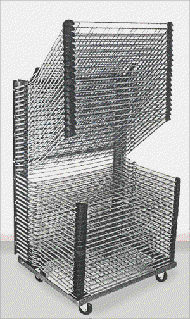 There should be a large folding, mobile metal rack for drying materials after washing. This can also be used for drying water-damaged materials.
There should be a large folding, mobile metal rack for drying materials after washing. This can also be used for drying water-damaged materials.
Many activities such as paste making require the heating of solutions, for which an electric hot plate, small stove, or electric paste maker similar to one designed for sauce can be used.
At least two standard benches will be needed, even if the unit is staffed by one conservator. The water supply entering the room should be run through multi-stage filters to reduce particulates and most metals.  It is also useful to have rolling tables for use in both the book and paper conservation units.
It is also useful to have rolling tables for use in both the book and paper conservation units.
Smaller items include plastic photograph development trays for use in washing and alkalizing paper in the sink, and screens to fit the trays for supporting paper. Non-ferrous metal should be used in the fittings or fastenings. These screens are similar to window screens and must be made to fit in the largest plastic trays. Two screens should be slightly smaller than the large sink to handle oversize objects. Thick plexiglass/perspex sheets of various sizes are needed for pressing of paper sheets along with a stainless steel hand-held spray for wetting material.
A paper press can be obtained or made. This is a large wooden press for applying 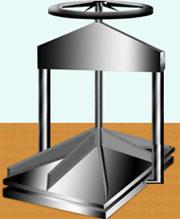 modest pressure to flat objects; the press should be mounted on a bench or table constructed for this purpose. Complementary pressing boards can also be made and lined on both sides with a plastic laminate. The unit will need ten boards 1.22 meters x 0.76 meters, ten boards to fit the steel presses in the bindery, and ten boards to fit the paper press.
modest pressure to flat objects; the press should be mounted on a bench or table constructed for this purpose. Complementary pressing boards can also be made and lined on both sides with a plastic laminate. The unit will need ten boards 1.22 meters x 0.76 meters, ten boards to fit the steel presses in the bindery, and ten boards to fit the paper press.
A mobile suction table incorporating stainless steel or plastic mesh should also be available. Materials are laid flat on its surface. Strong suction from below aids flattening and draws solvents through the paper fibers.
A humidification chamber can be homemade or purchased. The manufactured type incorporates a plastic chamber into which water vapor can be issued. Because this type of chamber is often used with the suction table, it should be designed to fit the table area.
Another necessary piece of equipment is a welder, either ultrasonic or radio. Both types attach polyester film at the edge to help encapsulate and protect badly deteriorated documents. The ultrasonic type is expensive but allows more flexibility. The radio welder uses heat to create the seal. Both welders need to be mounted, ideally on mobile tables.
The leaf caster combines paper pulp and suction for mechanical filling of holes and losses in paper. If the caster doesn’t have a special sink installed, it should be placed immediately adjacent to a sink.
Basic conservation supplies
The following supplies are generic, although some type names are used here:
• Spun polyester cloth. (Hollitex/Reemay are common brand names). Sold in rolls of various thicknesses, this polyester web fabric is used to support wet documents and mount damaged materials.
• Bookcloth. Sold in rolls and preferably coated with acrylic to deter insects, bookcloth is used to bind and repair books, cover boxes, and portfolios.
• Polyester film (Mellinex 516). This film is used for a variety of tasks, including encapsulation and the support of fragile documents.
• Blotting paper (thin and thick). This assists in the drying of wet material.
• Gortex. This is used to apply water vapor to documents with fugitive inks and colors for relaxation and separation. [not currently available]
• Barrier board (this is a brand name). This hard board is used for constructing boxes and portfolios.
• Binder’s board. This is used for binding and constructing boxes.
• File folder stock. This houses flat materials to be stored in steel files and boxes. It is also used for the construction of MM cases and portfolio flaps.
• Cover paper. This is used for protective covering and for the paper sides of half-bound books.
• Lignin-free, buffered text paper. This can be used for wrapping fragile materials and as a lining for portfolios and boxes. Sold in sheets or rolls in various thicknesses as “bond” or “ledger” paper.
• Adhesive. Polyvinyl-acetate (PVA) is used for box and portfolio making, methyl cellulose [add to glossary] powder for sizing and paper repair, and wheat or rice starch for paste for paper repair and leather binding.
• Sewing supplies. All conservation operations require needles, unbleached linen thread, and cotton or linen tapes.
• Heat-set tissue. This is torn into narrow strips for the low-moisture repair of paper tears without disbanding the book leaves.
• Repair paper/tissue. These are similar to thin, almost transparent Japanese tissues, such as tengujo, that have strong fibers.